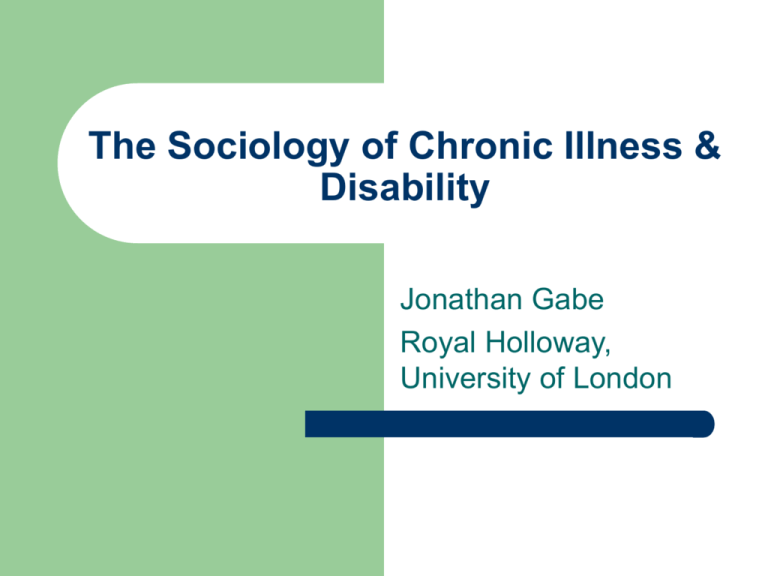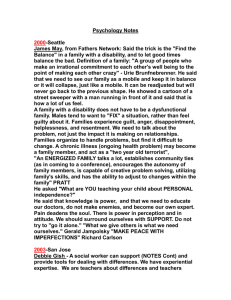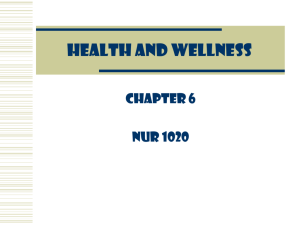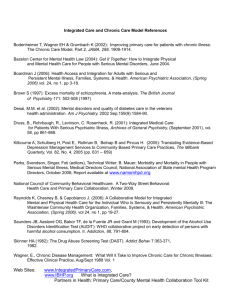The Sociology of Chronic Illness & Disability
advertisement

The Sociology of Chronic Illness & Disability Jonathan Gabe Royal Holloway, University of London Introduction Chronic Illness covers wide range of conditions epilepsy – arthritis – heart disease - asthma Has temporal dimension – chronic = khronos (Greek for time) – long lasting Insidious onset – difficult to diagnose – especially neurological conditions (MS) Uncertain trajectory / outcome - variation in symptoms day to day long term course Reasons for Sociological Interest (1) Ageing Population Structure in Developed Societies - demographic transition – decline in mortality/death rate all ages - increased life expectancy from birth - chronic diseases associated with later life (RA, stroke, CHD, dementia) Reasons for Sociological Interest (2) Problem faced by Medicine in managing /treating chronic illness - breakthroughs in treating older people (hip replacements, cataract surgery) BUT - doctors can only treat many illnesses of old age palliatively - minimise pain / help physical functioning Medicine looked to sociology - understand social psychological consequences of chronic illness - inform medical practice Sociological response 1. 2. 3. Socio-medical Interactionist / Post modern - treat together as both concerned with meaning of chronic illness & consequences Conflict - Disability Studies 1. Socio-Medical Approach (1) Developed by sociologists/social researchers in university Departments of Public Health 1960s on Aim – map extent of chronic illness/consequences for people USA – focus – impact of social conditions on chronic illness – poverty/social class related to onset of disorder - people’s ability to cope (Conover 1973) Socio-Medical Approach (2) UK – focus mapping the degree of Impairment - physical changes in people’s bodies UK survey (Harris 1971) - Age and impairment – 16-64 years – 4% - over 65 – 28% - Gender and impairment – women twice as likely to be impaired than men Socio-Medical Approach (3) Wood and Bury International Classification of Impairments, Disabilities & Handicaps (WHO 1980) Found Impairment / Handicap often used synonymously Attempt to clarify terminology used in research Impairment, Disability and Handicap (1) Impairment - Abnormality in structure & functioning of the Body Result of disease or trauma (e.g. road accident) Disability Restrictions to activities as a result of impairment Changes to what a person can/can’t do e.g. everyday tasks such as self care Recent version of the schema uses `activities’ rather than `disability’ Handicap Social disadvantages resulting from Disability or Impairment Focus on material or social needs Recent version of schema uses `participation’ rather than `handicap’ - Impairment, Disability and Handicap (2) Relationship between 3 dimensions not necessarily direct - some impairments not disabling - disfigured from fire but not disabled – can still do some activities. - BUT can cause handicap – response of others causes handicap Differences in severity on different dimensions - low degree of disability (tasks undertaken) but high degree of handicap (response of others) Disability not just present/absent - involves judgement about degree & varies with context Impairment, Disability and Handicap (3) Impact of conceptual clarification Research to measure the degree of disability - scale created – degree to which people’s movement affected by a) limited sight b) limited hearing Overall impact of this work - shifted focus from clinic to everyday life - influenced UK policy – benefits now less reliant on medical assessment. - BUT little scope for independent sociological voice 2. Sociological Approaches – Interactionism / Postmodernism Earliest e.g. of interactionist work in USA Strauss (ed) Chronic Illness and Quality of Life Series of condition specific studies Focus on `interactional difficulties’ faced by people with disabling illnesses 2 studies as illustrations Chronic Illness and Quality of Life (Anselm Strauss ed 1975) (1) Rheumatoid Arthritis (Weiner) Focus – How people with RA pass for normal Disguise symptoms to avoid negative response Maintain normal life by `balancing decisions’ - balance degree of effort required to remain normal V - consequences of not doing so Chronic Illness and Quality of Life (Strauss ed 1975) (2) Respiratory Illness (Fagerhaugh) Focus on way those with RI negotiate way through social life Try to manage symptoms of breathlessness & lack of oxygen Yet symptoms still intrude on quality of life BOTH STUDIES emphasise - need to maintain sense of order & self identity under conditions of considerable strain Strauss and Interactionism Chronic illness not just biological entity – patterned by social conditions. Also a negotiated reality – shaped by - decisions & tactics - employed by patients and others - emphasis on normalisation - varies according to time/ trajectory of illness - importance of contingency / context Illustrates symbolic interactionism’s view of society – product of interaction & negotiation Interactionist studies in the UK 5 examples – Jon Gabe, Mike Bury and Kelly & Field Living with asthma – Gabe et al (2003) Interview based study of 55 young people living in London, aged 8-16, 28 male, 27 female, with moderate to severe asthma Focused on the meaning of meaning of asthma – experiencing, explaining, managing Living with asthma Key findings: 1. Meaning needs to be related to context of everyday life - school and home - clinical & epidemiological literature focuses only on medical treatment. 2. Children/young people are actively involved with their condition and its management - not passive victims of disease - developed strategies to manage it – with help from friends, parents and teachers 3. Evidence of attempts to normalise having asthma - inhaler part of their lives at school & accepted by other children - dislike it if teachers treat them as `different’ Evidence of normalisation `So many have got it (asthma) that you can’t really leave people out (of sport) or everybody would be left out.’ (15 year old male interviewee) `I know I have asthma and I do limit myself but when people say `Oh you shouldn’t do this because you have got asthma’. I feel it is unfair, that they are blocking you and.. I just make myself do it, to show them just because I have got asthma I am no different.’ (11 year old female interviewee) Interactionism – the work of Mike Bury 1) 2) 3) Bury (1982, 1991, 1997) Sees chronic illness as `disruptive event’ - disrupting structures of everyday life 3 aspects of disruption Disruption of taken for granted assumptions/behaviour – about body Disruption to biography – self – re-examine plans for future Response to disruption – mobilize resources Chronic Illness as Biographical Disruption (Bury 1982) (1) Interview study of 30 people with RA, 25-54 years, mainly Female Onset and the Problem of Recognition No one recognised first signs of RA - Swolllen finger/early morning stiffness just a nuisance Onset insidious – seen as just wear and tear – too young to get RA Eventually admit symptoms to others & see GP The problem of recognition – an example `Well at first I thought I’d broken, chipped the bone in the finger, with it being a knuckle. I thought, I bet I’ve banged it, really, because I do bang my hands a lot sometimes and I thought I’d chipped it and thought `it will go off’. It was months really before I got round to going to the doctor because we got married in the July and I didn’t go to the doctor until September. I just thought it was one of those things that would clear up. It never dawned on me it would end up like this.’ (female interviewee. In Bury 1982:171) Chronic Illness as Biographical Disruption (Bury 1982) (2) Emerging disability and the problem of uncertainty Uncertainty about impact and course of condition & how should behave See disease as separate from self but such separation precarious - Disease as outside force yet feel invaded by it Diagnosis both a relief & source of fear - Prospect of growing dependency Chronic Illness as Biographical Disruption (Bury 1982) (3) Mobilisation of resources Presence/absence of social networks important Opportunity to re-organise workload. - may be limited – get little sympathy – worry about losing job Maintaining normal relations by mobilising resources at work `We’re getting some new work .. And some of the girls just seem to whistle through it, but it takes me all day to do it. She (supervisor) wouldn’t be too pleased, I know that for a fact. She’d say `Oh it’s not worth your while working here’. That’s the kind of thing you get if they know you are going to be off every so often. So I don’t say anything if I’m off, I’m just ill. The doctor doesn’t even put down what is wrong with me. I invent something and he puts it on the sick note. (female factory worker in Bury 1982:176) Health & Illness in a Changing Society (Bury 1997) Two types of meaning making when faced with Biographical Disruption Meaning as consequence - practical and social consequences - extent symptoms disrupt everyday life / increase uncertainty / awareness of disabling effects Meaning as significance - deeper level – how illness affects identity - how make sense of condition within broader cultural context - draw on images – negative – deformity with RA – soiling with bowel cancer - more positive – CHD because of overwork Coping Strategy & Style (Bury 1991) (1) People adapt to challenges to identity & life style posed by chronic illnesses in 3 ways Coping The way in which people put up with illness & disability Involves cognitive and emotional dimensions Come to terms with limitations resulting from bodily changes Severity of symptoms/stigma attached important e.g. for epileptics infrequent seizures easier to cope with. Coping, Strategy & Style (Bury 1991) (2) Strategies How people try and manage their condition Availability of resources important Level of social support & material factors Worst off face most difficulties Style Focus on performance Planning, rehearsing & evaluating own actions with other people in mind Some choice of style possible – keeping active The Body in Chronic Illness (Kelly and Field 1996) Kelly & Field argue that sociologists focused too much on Meaning of chronic illness Paid insufficient attention the body, especially in culture dominated by individualism, self awareness & body maintenance How does chronic illness impact on the body? Impinges on people’s capacities/shapes identity Attempt to maintain sense of continuity in face of bodily change But no longer possible to take body for granted - e.g. when forced to use wheel chair – changes public identity whatever the meaning of impairment for individual Assessment of concept of Biographical Disruption (1) 1. 2. Concept widely used to understand how people make sense of chronic illness - RA to stroke BUT how useful is it? What are its limitations? Based on adult centre model – what about conditions from birth, early years? Part of self from birth = biographical continuity Ignores illness as normal crisis for working class/elderly - to be expected like hard work or `being old’ - stroke seen as `not that bad’ rather than `shattering life’ Assessment of concept of Biographical Disruption (2) 3. Condition might be biographically reinforcing instead – HIV for haemophiliac confirms life time experience of illness - HIV for gay men reaffirms their personal and political struggle/identity 4. In post modern world of constant biographical re-appraisal ( a consequence of consumer culture) - diagnosis of chronic illness just involves one more biographical revision. 5 Conclude – can’t assume chronic illness involves biographical disruption – need to take account of meaning & context, timing & expectation. 6. What is disruptive for some is part of daily life for others. (Williams 2000) Postmodern approach to chronic illness (1) According to Frank (2004) need to go beyond - simply documenting patient’s perspective - how people normalize effects of illness/disability Instead focus on the culture in which people located and how this provides them with multiple discourses to interpret their world, reinvent their identities. See chronic illness in positive terms – embarking on a journey/odyssey - by facing up to what lost – transcending it Supports idea of biographical re-invention rather than disruption Postmodern approach to chronic illness (2) Instead of people with chronic illness being concerned to stabilize/normalize condition. They are seen as embarking on - ceaseless/nomadic journey - a journey with no clear end Chronically ill now part of `Remission Society’ - large numbers of people with chronic illness - but recovering from it – facing life with illness in remission Links between body/self/society not one of interactional difficulties but a shifting terrain – where individuals constructing new identities A useful rebalancing but over optimistic? 3) Sociological Approaches – Conflict / Disability studies Developed by Disability Movement & academics (e.g. Mike Oliver in UK) Conflict theorists critical of interactionism a) focuses on micro / social psychological level - ignores structural / macro level b) focuses on specific conditions rather than commonality of experience Alternative focus on social oppression not personal tragedy – rights not needs Social Oppression Model (Oliver 1996) (1) Disability a social not individual phenomenon Disability is socially constructed - a result of practices & perceptions that seek to exclude those who deviate from norm of able bodied e.g. in built environment WHO definition of Disability rejected preferred definition some similarity with WHO definition - Handicap = Social Disadvantage Social Oppression Model (Oliver 1996) (2) Exclusionary Practices reflect requirements of capitalism - define what attributes - productive/acceptable - unproductive/abnormal Portraying Disability as feature of individual - reinforces Ideology of Individualism Medicine’s role to Regulate & Manage disability Solution political – challenge oppression collectively. Impact of social oppression model Gained influence with organisations that fund research and practitioners in social care Been criticised by sociologists of chronic illness Feel it has an over-socialised view of disability By focusing on political dimension – discrimination/oppression – Ignore fact that many disabled chronically ill have needs not just rights – especially older people People with different chronic conditions have different experiences Response of disability movement Reject criticism of sociologists of chronic illness as missing the big picture Tension between the 2 positions may be irresolvable However some within the disability movement - accept need to make some distinction between different impairments - recognise that some of those with disabilities have health care needs which others don’t have. Some sociologists of chronic illness recognise must take more account of structural forces Conclusion Discussed three approaches to chronic illness/disability Socio-medical model Interactionist/Postmodern Conflict approach of disability movement Each approach asks different questions and thus makes a different contribution. Each has a place in a world where chronic illness & disability growing as part of the demographic transition. References Bury, M. (1982) Chronic illness as biographical disruption, Sociology of Health and Illness 4: 137-69. Bury, M. (1991) The sociology of chronic illness: a review of research and prospects, Sociology of Health and Illness 13: 451-68. Bury, M. (1997) Health & Illness in a Changing Society, Routledge, London. Conover, P. (1973) Social class and chronic illness, International Journal of Health Services, 3: 357-68. Frank, A. (2004) When bodies need voices. In Bury M and Gabe, J. (eds) The Sociology of Health & Illness: A Reader. Routledge, London. Gabe, J. et al (2002) living with asthma: the experiences of young people at home and at school, Social Science & Medicine 55, 575-98. Kelly, M. and Field, D. (1996) Medical sociology, chronic illness and the body, Sociology of Health and Illness 18: 241-57 Oliver, M. (1996) Understanding Disability: From Theory to Practice. Macmillan, Basingstoke. Strauss, A. (ed)(1975) Chronic Illness and the Quality of Life. Mosby, St Louis. WHO (1980) International Classification of Impairments, Disabilities and Handicaps. WHO





